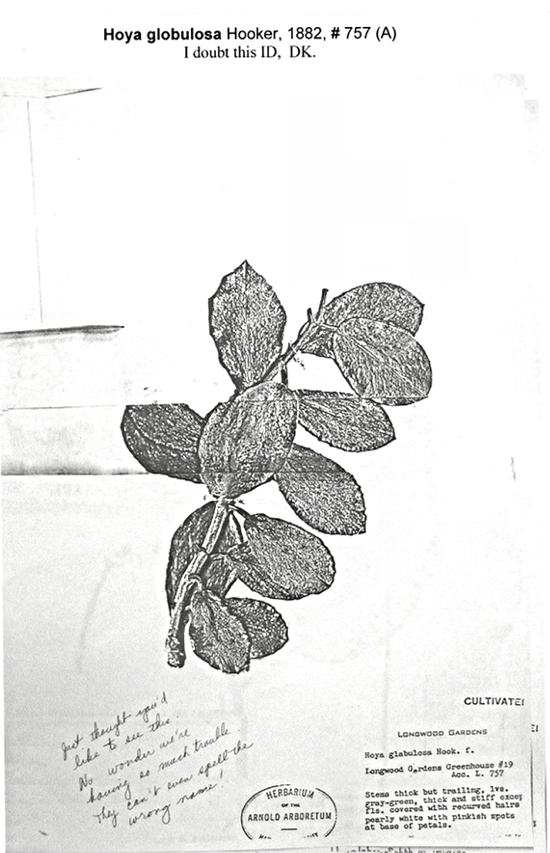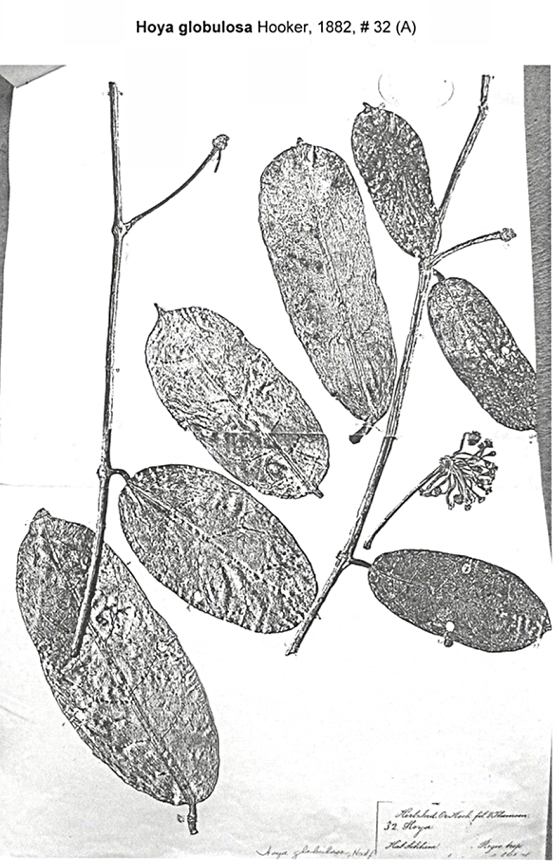
Hoya globulosa Hooker 1883
In Floral Magazine (1880) 406. Hoya globulosa, Hook. f. Under the name of Hoya Globulosa, the Cranston Seed and Nursery Company. Hereford, exhibited at the meeting of the royal Horticultural Society, on April 13th, a charming Hoya, so pretty and distinct as to merit and receive a First-class Certificate on Merit. Some doubt being expressed as to whether is was this species or not, the plant was referred to Kew for the opinion of the authorities there, and Sir J. D. Hooker has informed the Company that “the Hoya you wrote about is a plant discovered by myself in India in 1849, and specimens of it collected by me are in the Herbarium here. I have called it H. globulosa, Hook. f.”
We can confidently recommend it as a most useful and valuable plant, blooming profusely and thriving well under the same treatment as other Hoyas. The flowers are of a bright straw colour, the coronal protuberances white, the interstices of a shining brownish-pink, forming a very pleasant contrast; trusses large and freely produced; and the leaves of a shining green colour, with dark green veins.
In the Gardener’s Chronicle 2 (1882) 732. J. D. Hooker f. Hoya globulosa, Hk, f. ined. (fig. 115, p. 741). This is newly introduced from Sikkim Himalaya, where it was discovered by Sir Joseph Hooker, who is the sponsor for the name, though he has not hitherto, unless we are mistaken, published it. The plant was sent out by the Cranston Nursery Company, Hereford, who have exhibited it on several occasions, and who kindly furnished the materials for our illustration.
In The Gardener’s Chronicle (1882) 570. Fertilization of Hoya globulosa. Mr. W. G. Smith refereed to this subject and exhibited Hoya flowers with flies attached to the glutinous discs of the pollen masses. This hoya is highly fragrant; this fragrance is very attractive to insects and it is by insect agency alone that flowers can be fertilized in the state of nature. The flowers of the Hoya differ from Orchids in their perfectly regular form, but they agree somewhat in their pollen grains, which are grouped in masses of two placed in five small pouches. The five little gelatinous dark coloured disks, belonging to the bases of the pollen masses, are the only parts visible in the open flower. In Hoya there are five pairs of pollen-masses arranged regularly round the centre of each flower. When insects alight on the flowers (attracted by the powerful fragrance) it is almost inevitably happens that one foot slips and gets caught by one of the five gelatinous discs. In the effort of the insect to escape, two, three, or even four to its other feet are almost sure to get similarly caught. The insect then tries with all its power to free its limbs, and if these efforts are successful the pollen masses are drawn out of the pouches with the feet. The basal appendages of each pair of pollen masses are elastic, and when in the pouches are like an extended spring, but the instant the masses are drawn out by the insect’s foot the spring closes, the two pollen masses quickly cross each other and hold tightly on to the insect’s little claws. If the insect is week it cannot withdraw its legs at all, and so perishes in the flower; but if strong it flies away with one to five pairs of pollen-masses clasped round its feet. Sometimes an insect breaks part of a leg off in its efforts to escape. The five stigmas are not ready to receive the pollen at the time the pollen is ripe, so that it is only when the insect re-alights on to some neighboring Hoya flower in a different stage of growth that cross-fertilization takes place.
In Flower Garden 2 (1883) 95-96. Paxton. Hoya globulosa. Although this species has much in general character, in its habit of growth, and conformation of its flowers, with several others of the family — the Cunningham Hoya (H. Cunninghami), for instance— still, from the cultivator’s point of view, it is sufficiently distinct to make it an acceptable addition to our warm house climbers. One advantage possessed by this and other twining Hoyas is that they are not such coarse rampant growers as many stove climbers are, consequently do not too much shade the plants the plants grown beneath them in houses where they are suspended on the rafters overhead. H. globulosa will no doubt succeed under like conditions to most of the other species, thriving in ordinary loam or peat, with too much pot-room. It will most likely not require more warmth than that of an intermediate house. It has been recently sent out by Cranston Nursery Company, Hereford, who exhibited it London. The plant is thus described in the Gardener’s Chronicle, p. 732, vol. xvii.
Leaves oblong, leathery, rounded or subcordate at the base, acuminate at the apex. Flowers in globose umbels, ground-colour pale straw or cream, coronal appendages pink at the base. A native of the Sikkim Himalaya.
Compiler’s Notation: No Hoya with the name of Cunninghami has ever been written up (described).
Type description:
** In Flora of British India 4 (1883) 60. J. D. Hooker. 34. H. globulosa, Hook f. in Gard. Chron. 1882, ii 732, f. 115; more or less hairy, leaves 5-7 in. long-petioled elliptic or oblong cuspidate or acuminate base rounded midrib very stout, nerves distinct, peduncle long, pedicels villous, corona nearly glabrous within. Floral Magazine, 1860* t. 406. — Hoya n. 30 and 33; Herb. Ind. Or. H. f. & T.
Sikkim Himalaya; alt. 1-3000 ft. J. D. H., Clark. Assam; Muku hills. Simmonds. Cachar, more or less hairy, the hairs long and very deciduous. Leaves 2-3 ½ in., pedicels 1 in. Sepals rounded. Corolla1/2 in. diam., cream coloured; lobes short, incurved. Corona-processes short, broadly elliptic, pink concave above, inner angle produced into an erect spur which is shorter than the large broad anther tips. Follicles 12-16 in. long, very slender, cylindric, pericarp thin. — seeds ½ in. long, slender.
* Reported here as 1860 should be 1880.
** This appears to be the first description of this species.
In Dictionary of Gardening 2 (1884) 155. George Nicholson. H. globulosa (globular)* fl. pale straw or cream-colour, disposed in globose umbels; corona pink at base. April. l. oblong coriaceous, rounded at the base, acuminate at the apex, more or less hairy. India, 1880. (G.C. n.s., xvii. 741.)
In Flore Generale des Indo Chine 4 (1912) 140 J. Constantin (H. M. LeConte) . 21. H. globulosa Hook. in Gard. Chron. 1882, II, p. 732, fig. 115; Floral Magaz., 1860, tab. 106*.
Tige glabre ou avec quelques poils. Feuilles elliptiques ou oblongues, arrondies a la base, cuspidees ou acuminees; nervure mediane teres vigoureuse avec quelques glandes et poils a la base; nervures secondaires obliques et arquees. Inflorescence: ombelle multiflore portee sur un pedoncule aile poilu ou glabre, long de 7-8 cm.; pedicelles greles, longs de 1.5-2 cm., couverts de poils ocraces ou jaunatres. — Calice a sepales arrondis, poilus et cilies. Corolle de 10-12 mm.; lobes triangulaires-aigus, courts et incurves, pubescents inrerieurment et cillies fortement aux bords. Coronule a 5 pieces courtes, largement elliptiques, rosees, concaves en dessus, presentant a la partie interne un eperon dresse qui est plus court que l’extremite large des antheres. Fruit: follicules longs, tres greles, cylindriques, longs de 30-40 cm., a pericarpe mince; graines greles (8 mm.).
Cochinchine: Mt. La (Pierre). — Indes angl.
Pedicelles poilus.
Poils des pedicelles jaunatres; feuilles grandes, allongees (13 cm. x 5.5 cm.)........ 21 H. globosa.
* The citations here are incorrect. The year is 1880 and the tab. is 406.
Translation: Glabrous stem or with some polishes. Elliptic or oblong, leaves rounded at the base, cuspidate or acuminees; midrib vigorous teres with some glands at the petiole base; secondary nerves turn off and are arched. Inflorescence: umbulate multiflowered reach on a shaggy or glabrous stalked wing, 7-8 cm. long; spindly pedicels, 1.5-2 cm. long, covered with a few hairs ocraces colored. - Calyx is rounded, shaggy sepals and ciliate. Corolla of 10-12 mm.; triangular-shaped, short lobes and curved, pubescent inwardly and very ciliate at the edges. Corona has 5 short, extensively elliptic pieces, dews, concave on top, presenting has the internal part in a spur that is shorter than the large extremities of the anthers. Fruit: long, very spindly, cylindrical follicles, 30-40 cm. long, has thin pericarpe; spindly seeds (8 mm.).
Cochinchine: Mt. La (Pierre). - Indies angl.
Shaggy Pedicels.
Pedicels glabrous yellow; leaves large (13 cm. x 5.5 cm.)........ 21. H. globosa.
In Journal of the Linnean Society 43 (1915) 476. C. C. Lacaita. Hoya globulosa, Hook. fil. Glen S. E. of Kalimpong, c 1900’, 23. iv. (16041).
In Standard Cyclopedia of Gardening and Horticulture (1930) 1603. F. H. Bailey. Hoya globulosa, Hook. f. Hairy: lvs. elliptic-oblong or long-oblong, acuminate, rounded at the base, the midrib very stout, the petiole an inch or less long: fls. pale straw-or cream-color, the star like crown-segms. white, with pink at the base, borne in dense, globular umbels: follicles a foot or more long, Sikkim. F. M. 1880:406. G.C. II. 17:741.— A handsome species, requiring a general given to H. carnosa.
In The Royal Horticulture Society Dictionary of Gardening (1965) 1016. (1st Ed. 1951). H. globulosa l. oblong, rounded at base, slender-pointed, leathery, more or less hairy. fl. pale straw or cream, in globose umbels; corona pink at base. April. Sikkim. 1880. (G. C. 17 (1882), 741.) Succeeds with the same treatment as H. carnosa.
In Journal of the Royal Horticultural Society (1973). A. J. Wills. Hoya globulosa. Scent is over-poweringly heavy and languid, reminiscent of sweet chestnuts.
In Illustrated Florae di Cera. Ann. Fac. Agric. 27 (1975) 340. Giancinto Donno. Hoya globulosa Hook. Pianta tomentosa. Foglie elliptico-oblunghe, acuminate, arrotondate alba base; la nervatura principale ben robusta, il picciuolo di circa 3 cm o meno; foglie crema-paglia-pallida; la corolla* stellata bianca con color rosa o rosso alba base, constituisce un’ombrella globulosa compatta, follicoli lunghi 30 cm o piu;
* the word here should read “corona” not corolla.
Translation: Tomentose plant. Leaves elliptic-oblong, acuminate, rounded at the base; the principle nerves very prominent, the stalk is about 3 cm or less; leaves pale cream-straw; the corona starlike white with rose or reddish white at the base, forming a globose compact umbel, follicles 30 cm or more long.
In Exotica III 9th Ed. (1978) 1631. A. B. Graf. Hoya globulosa (Sikkim, Himalayas) , slender vine with thick oval-pointed, spoon-like, lightly hairy leaves, and round clusters of cream colored waxy flowers, the corona marked brown-red at base,
In Botanical survey of India, Calcutta “Bengal Plants” 2 (1983) 519. D. Prain (R.K. Basak) 269. Hoya globulosa Hooker. f. F. B. I. iv. 60. Chittagong A stout climber.
In The New Royal Horticulture Society Dictionary of Gardening 2 (1992) 596. H. globulosa Hook. f. Climbing with downy stems and branches. Lvs. to 15cm. oblong, puberulent, leathery, base rounded. apex mucronate. Umbels globose, many-fld: cor. lobes cream-yellow or straw-yellow; corona with a pink base, apex cream. Spring, summer. N. India, Nepal, Tibet. Z9.
In Tropica 4 (1992) 1020. A. B. Graf. Hoya globulosa (Sikkim, Himalayas); slender vine with thick oval-pointed, spoon-like, lightly hairy leaves, and round clusters of cream colored waxy flowers, the corona marked brown-red at base. Subtropical.

